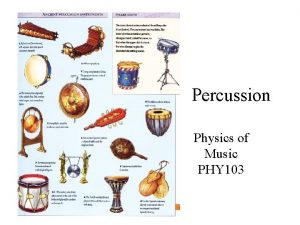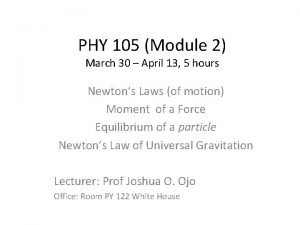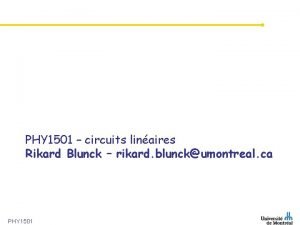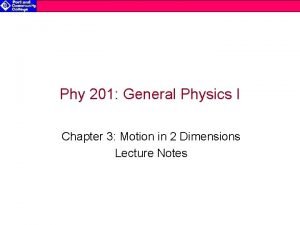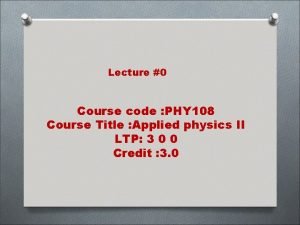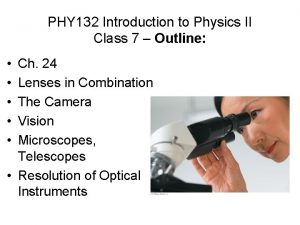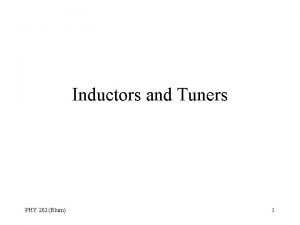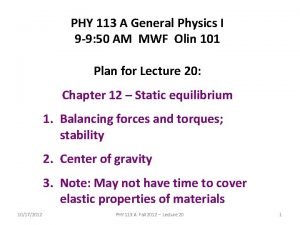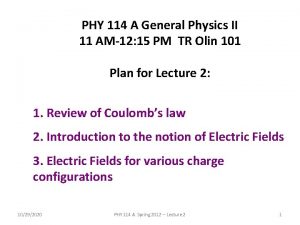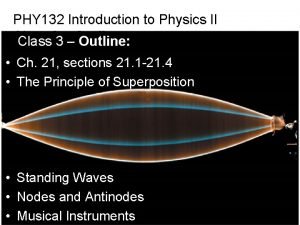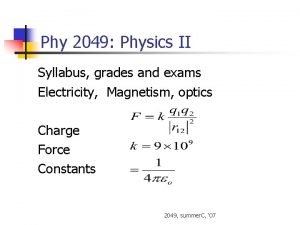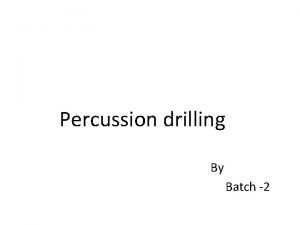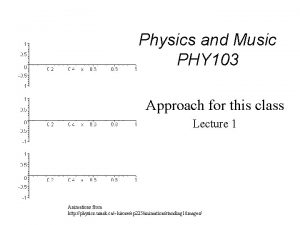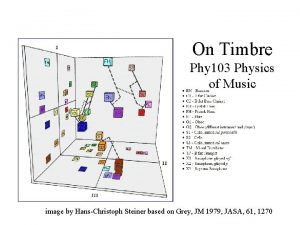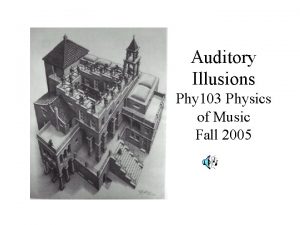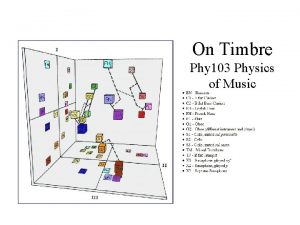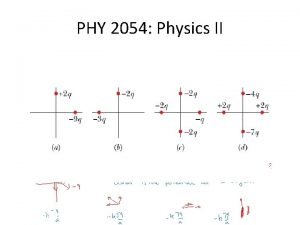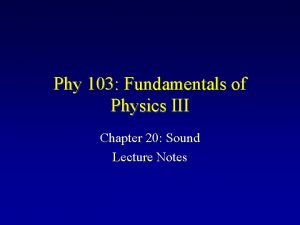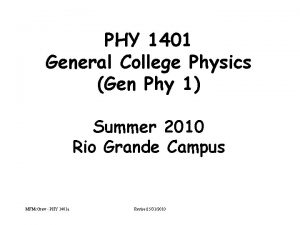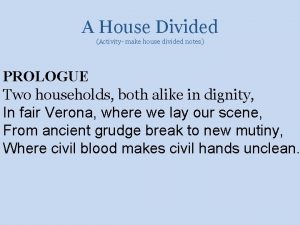Percussion Physics of Music PHY 103 Percussion Divided




































- Slides: 36

Percussion Physics of Music PHY 103

Percussion Divided into • Membranophones: drums and • Ideophones: chimes, xylophones, marimbas, jawharps, boos, tongue drums, bells, gongs Could also be divided into those with pitch and those without

Membranes modes of vibration • The first three modes C 1, C 2, C 3 are axisymmetric (circular rings). • The last 2 modes have azimuthal structure (bilateral) L 1, L 2 • C vs L mode spectrum depends on where you hit the drum. You get higher frequency vibrations when you hit the edge of the drum C 1 f 1 C 2 2. 3 f 1 sharp major 9 th C 3 3. 6 f 1 octave + minor 7 th L 1 1. 59 f 1 minor 6 th L 2 2. 92 f 1 octave + 5 th

Resonances of the membrane • By changing the tension on the membrane you can change the pitch of the drum (experiment with flatdrum!) • By making the membrane heavier you should be able to lower the pitch

Resonances of the drum vs that of the body • A: frame drum • B: Tenor drum • C: Barrel drum with narrow opening • D: Barrel drum with large opening • E: tube drum

Resonances of the drum vs that of the body • A: No added resonance -out of phase waves from front and back cancel • C: Membrane and barrel could have different resonances- barrel usually has a deeper tone than the drum head – narrow resonance peak for barrel • D: Barrel might have a wider resonance peak

Drum tuning • Adjusting the tension of the drum head changes the resonant frequencies of the drum head • It also changes the resonant frequencies within the drum chamber --- this is because the rigidity of the walls affects these resonances • Process of adjustment required to have the resonances of the membrane reinforce the resonances of the drum body --- leading to a fuller sound

Spectrum of a drum Toca drum

Drum ensemble from Benin Sound box of wood with a laced skin membrane. The sound changes when stuck at different positions on the drum head. Music taken from CD Musical instruments of the World 1990 CNRS

Frame Drum • Example from Rajasthan • One meter large, can be hit by more than one player

Goblet Drum Darbuka • Egypt • Goblet with a glued membrane of lambskin • Tone quality is adjusted solely from changes of power and angle of attack

Spectrum of Darbuka

Tabla India • Note vocalization following • membrane thickness varies so sound is very sensitive to position hit

Steel pipe • Modes exited depend on where you hold it

Steel pipe held at different locations • Note first overtone absent in green spectrum

Instruments made in this class 2005 and before • copper pipe xylophone • glass xylophone • solid aluminum chimes

Copper pipe with slit cut to different lengths

Jaw Harp (Rajasthan, moorchang)

Lamellaphone – Sanza -west africa

Slit Drum -central Africa • hollowed out wood with uneven thickness to the edges

Guinea Bala Xylophone

Clay percussion Claycussion • Ward Hartenstein and the Eastman percussion ensemble • from Gravikords, Whirlies and Pyrophones

Double pit xylophone Benin doso pit dug into the ground serves as a resonator

Stamping tubes. Solomon islands Bamboo pipes striking a rock or the ground The bamboo tube is held in one hand, the closed end at the bottom, and struck against the ground or a hard surface. The palm of the other hand partly opens or closes the open end, changing the timbre. Image from http: //www. folkenberg. net/Travel%20 highlights/97%20 SPD/97 -2 Solomon_islands-2. htm

http: //www. nccapoeira. com/music/toques. html

Stomping tube spectrogram flat + open/closed end pipe spectrum

Angklung-sliding rattle Java

Angklung spectrogram

Gamelan – Bali – Metallophone Ensemble

Archeology of Chinese Bells An ensemble of 65 bells, with 130 discrete strike tones, was excavated in a fully preserved state 1978 in the Chinese province of Hubei from the tomb of the Marquis Yi of Zeng from 433 B. C. The ensemble's tuning system could now be investigated! http: //web. telia. com/~u 57011259/Zengbells. htm (Martin Braun)

“Two Tone” bells • Due to favorable conditions of tomb preparation, soil, and soon natural water filling, the bronze of the bells survived fully intact. The bells sound as they did 2, 436 years ago. • The bells have an eye-shaped cross-section and vibrate in one of two modes, depending on where they are struck. A strike in the middle of the front makes frontside and backside vibrate as whole units and produces the lower tone sui. A strike between the middle of the front and a side edge makes frontside and backside vibrate as two units each and produces the higher tone gu. If struck correctly, both tones are fully independent, each with its own fundamental and harmonics.

Two tones (continued) • The two tones a third apart, purposely

Evidence for tuning Images from The Archeology of Music in Ancient China, Kutner, Fritz

The scale • Scale D-E-F-G-A-C occurs eight times in melody bells

The bumps? • • • Western bells rarely have bumps --- Church bells have lasting rings. Players of handbells damp the sound if they require a short note Bumps do change the modes of oscillation as they give extra mass They also help radiate sound and so damp the sound purposely The bell can be louder?

Topics • Resonances/modes of a membrane • Modes of a vibrating pipe or bar • Modes of a resonating cavity coupled to a membrane • Membranophones/ideophones and lamellaphones • Suggested reading: Chapters 4, 5, 7 of Hopkins
 Music music music
Music music music Physics of percussion instruments
Physics of percussion instruments Physics
Physics Phy-105 5 discussion
Phy-105 5 discussion Phy circuit
Phy circuit Phy113
Phy113 Real image
Real image Eye phy
Eye phy Phy 1214
Phy 1214 Phy
Phy Phy theorem
Phy theorem Atm packet phy
Atm packet phy Phy108
Phy108 Phy 121 asu
Phy 121 asu Loncapa fsu
Loncapa fsu Phy 1214
Phy 1214 Phy 1214
Phy 1214 Phy 2049
Phy 2049 What is farsightedness called
What is farsightedness called Felix connects a wire coil to an ammeter
Felix connects a wire coil to an ammeter Phy 221 msu
Phy 221 msu Fizik ii
Fizik ii Phy tgen
Phy tgen Ddr phy architecture
Ddr phy architecture Examples of convection
Examples of convection 2012 phy
2012 phy Phy 131 past papers
Phy 131 past papers Phy
Phy Phy
Phy Phy
Phy Phy 132
Phy 132 Life phy
Life phy Phy theorem
Phy theorem Phy 2049
Phy 2049 Phy 205
Phy 205 General physics measurement
General physics measurement Law of motion
Law of motion

